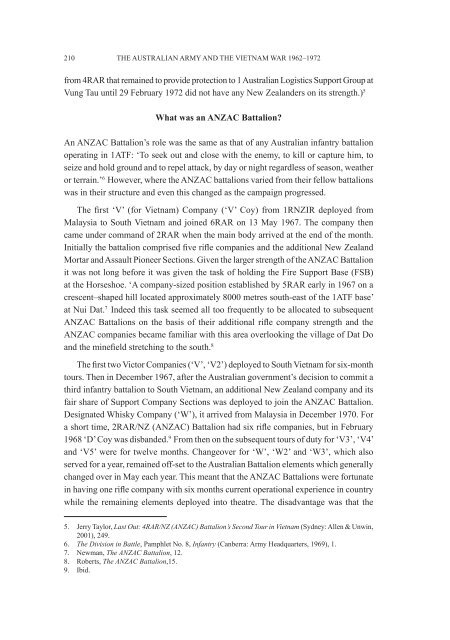conference proceedings - Australian Army
conference proceedings - Australian Army
conference proceedings - Australian Army
You also want an ePaper? Increase the reach of your titles
YUMPU automatically turns print PDFs into web optimized ePapers that Google loves.
210<br />
THE AUSTRALIAN ARMY AND THE VIETNAM WAR 1962–1972<br />
from 4RAR that remained to provide protection to 1 <strong>Australian</strong> Logistics Support Group at<br />
Vung Tau until 29 February 1972 did not have any New Zealanders on its strength.) 5<br />
What was an ANZAC Battalion?<br />
An ANZAC Battalion’s role was the same as that of any <strong>Australian</strong> infantry battalion<br />
operating in 1ATF: ‘To seek out and close with the enemy, to kill or capture him, to<br />
seize and hold ground and to repel attack, by day or night regardless of season, weather<br />
or terrain.’ 6 However, where the ANZAC battalions varied from their fellow battalions<br />
was in their structure and even this changed as the campaign progressed.<br />
The first ‘V’ (for Vietnam) Company (‘V’ Coy) from 1RNZIR deployed from<br />
Malaysia to South Vietnam and joined 6RAR on 13 May 1967. The company then<br />
came under command of 2RAR when the main body arrived at the end of the month.<br />
Initially the battalion comprised five rifle companies and the additional New Zealand<br />
Mortar and Assault Pioneer Sections. Given the larger strength of the ANZAC Battalion<br />
it was not long before it was given the task of holding the Fire Support Base (FSB)<br />
at the Horseshoe. ‘A company-sized position established by 5RAR early in 1967 on a<br />
crescent–shaped hill located approximately 8000 metres south-east of the 1ATF base’<br />
at Nui Dat. 7 Indeed this task seemed all too frequently to be allocated to subsequent<br />
ANZAC Battalions on the basis of their additional rifle company strength and the<br />
ANZAC companies became familiar with this area overlooking the village of Dat Do<br />
and the minefield stretching to the south. 8<br />
The first two Victor Companies (‘V’, ‘V2’) deployed to South Vietnam for six-month<br />
tours. Then in December 1967, after the <strong>Australian</strong> government’s decision to commit a<br />
third infantry battalion to South Vietnam, an additional New Zealand company and its<br />
fair share of Support Company Sections was deployed to join the ANZAC Battalion.<br />
Designated Whisky Company (‘W’), it arrived from Malaysia in December 1970. For<br />
a short time, 2RAR/NZ (ANZAC) Battalion had six rifle companies, but in February<br />
1968 ‘D’ Coy was disbanded. 9 From then on the subsequent tours of duty for ‘V3’, ‘V4’<br />
and ‘V5’ were for twelve months. Changeover for ‘W’, ‘W2’ and ‘W3’, which also<br />
served for a year, remained off-set to the <strong>Australian</strong> Battalion elements which generally<br />
changed over in May each year. This meant that the ANZAC Battalions were fortunate<br />
in having one rifle company with six months current operational experience in country<br />
while the remaining elements deployed into theatre. The disadvantage was that the<br />
5. Jerry Taylor, Last Out: 4RAR/NZ (ANZAC) Battalion’s Second Tour in Vietnam (Sydney: Allen & Unwin,<br />
2001), 249.<br />
6. The Division in Battle, Pamphlet No. 8, Infantry (Canberra: <strong>Army</strong> Headquarters, 1969), 1.<br />
7. Newman, The ANZAC Battalion, 12.<br />
8. Roberts, The ANZAC Battalion,15.<br />
9. Ibid.

















